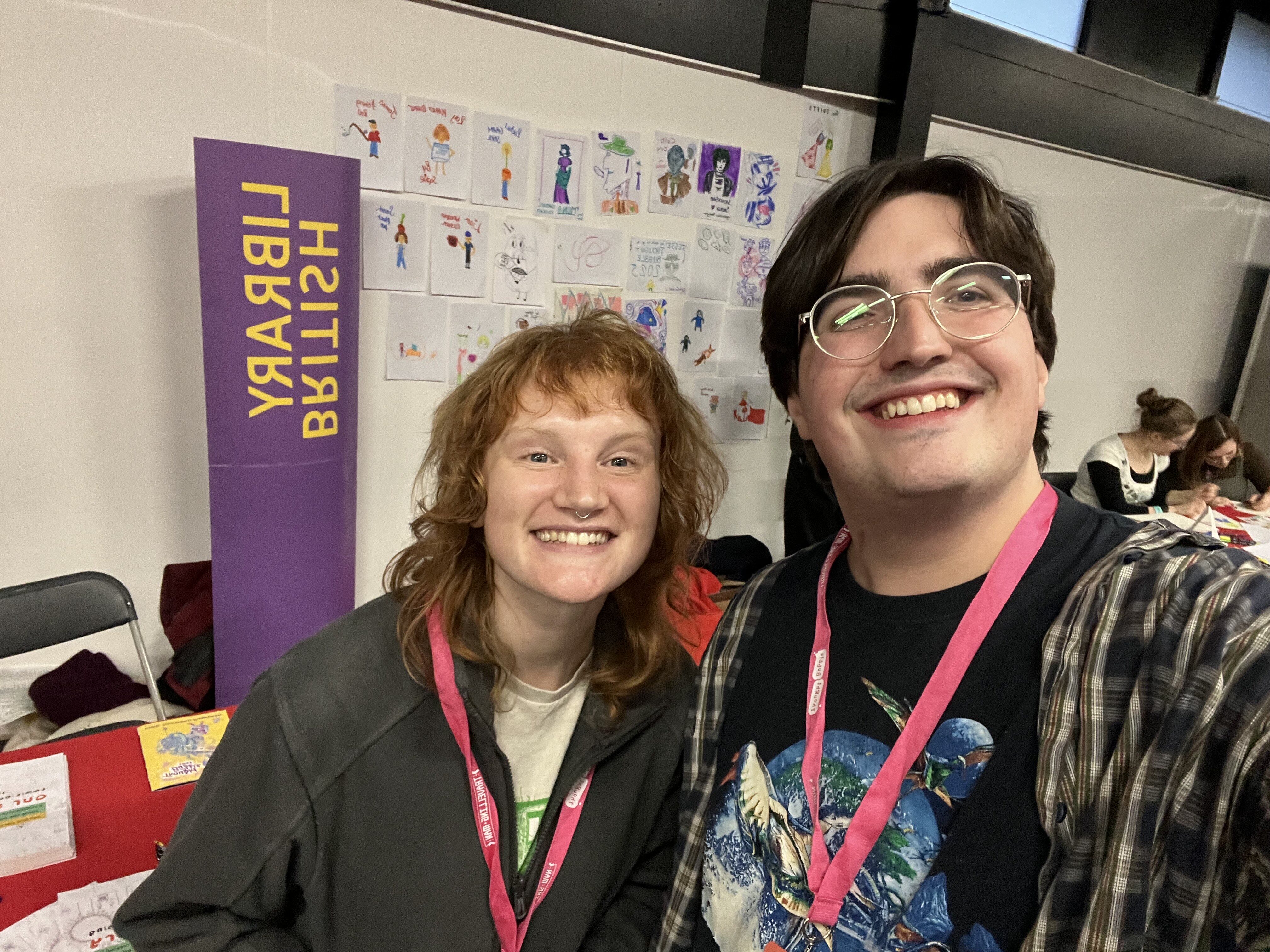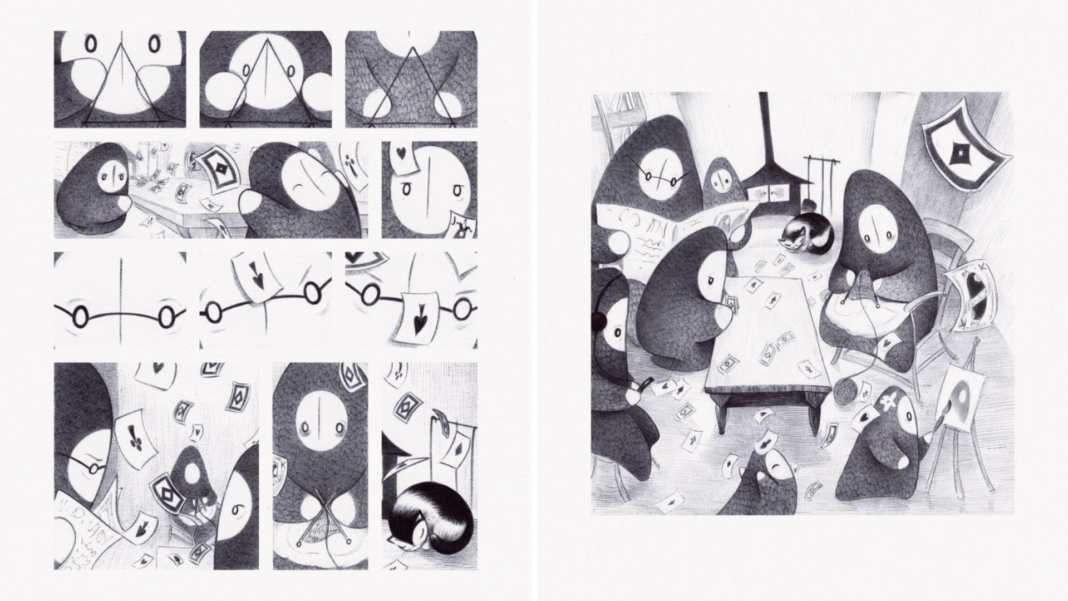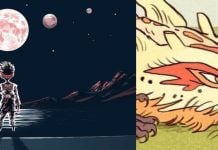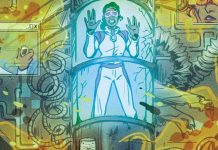Mollie Ray’s exceptional debut graphic novel Giant is a strikingly intimate and emotional look at nostalgia, illness and healing, told with a deft and gentle hand that lead to one of the best comics of last year. Recently reprinted into a brand new paperback, Ray has gone on to be elected the inaugural Youth Comics Laureate of the United Kingdom, using their platform for major comics activism projects across the country, even outside of it.
We at The Beat sat down with Ray at Thought Bubble Comics Art Festival 2025 to discuss the making of Giant, it’s gentle storytelling, and the powerful impact of comics.
This interview has been edited for clarity.
Jared Bird: Thank you so much for your time. Giant came out in June 2024 from Faber & Faber books and recently had a paperback edition. To those unfamiliar, how would you explain Giant?
Mollie Ray: Giant is a silent graphic novel based on the experience that my brother and my family went through when he was diagnosed with cancer. The main character wakes up one day to find they’ve grown to be the size of a giant, which is a metaphor for the physical mutation of cancer, and feeling like you’re the elephant in the room, literally.
Bird: What led to you wanting to tackle that story in graphic novel form?
Ray: When my brother was going through chemotherapy, I had this drawing in my mind of this family sitting around trying to have a normal meal and get on with their lives except one of them is giant. They’re trying to live this normal experience but something else is right there. I drew that picture but I couldn’t deal with it at that moment. It was too raw, and I came back to it a year later and I wanted to get everything out. I didn’t have the words, so it naturally came out as pictures, as a silent comic.
I had read a lot of beautiful graphic novels that had helped me, like Lighter Than My Shadow by Katie Green, which was really important to me when I was going through anorexia as a teenager. I know that there’s a huge value not just in expressing your own experiences for you therapeutically, but the good it can do for others as well.
Bird: What has it been like to work with Faber & Faber?
Ray: Amazing. They’re brilliant. They’ve been really supportive, and they gave me a lot of creative freedom. They knew it was a very personal story to me, so they were very sensitive, but they gave me direction when I needed it. They’ve been brilliant and put a lot of care into the production of it and trying to reach different places and opportunities.
Bird: The characters of Giant have a very specific design, almost reminiscent of something like the Moomins. How did you come up with their collective appearance?
Ray: I realised that the shape was very reminiscent of a Russian doll, and at the time I was drawing these characters, I was also doing a lot of Russian doll-themed commissions for people of their families. I really loved that it was a very soft and cuddly shape. It’s very cosy, comforting and relatable and you just want to smush them. The scales are like the fish, so it ties to the metaphor of the fish throughout the book. You don’t need to know that to understand the book though.
Bird: Much of the comic is silent, with minimal to no dialogue. Was that a challenge to create?
Ray: Massively. When you’re trying to communicate something and you’ve got no words, everything has to be as clear and crisp as possible so it gets through. There’s still the beauty of the silence, which allows you to project your own experiences onto it, so it becomes relatable to the individual reader. It’s more interpretive and it doesn’t matter as much if you don’t get every single thing I was conveying, because it’s now your story when you read it.
Bird: Something I adored about Giant is the hazy, nostalgic element of it that created a very genuine emotional centre to the book. How did you go about creating that atmosphere?
Ray: That’s really lovely. It’s interesting that you say that because I purposefully wanted the shapes of everything to be quite simple, like the cars which appear very two-dimensional. It creates that relatability, simplifying so that it could be somewhere that you’ve lived or could remember, or somebody you could know.
An archetype of a mother or a father. That, to somebody, is their mom, it’s my mom, it’s someone’s grandmother. It’s not giving too much, it’s letting the reader fill in the gaps. Having that very monochrome, soft, fluffy texture helps. I loved that you could achieve that texture with a ballpoint pen. That all adds to that.
Bird: Comics manipulate the spaces between the panels and how that makes you feel. You’re filling in the blanks yourself.
Ray: The borderless panels add to the nostalgia, because they look like photos or something similar.
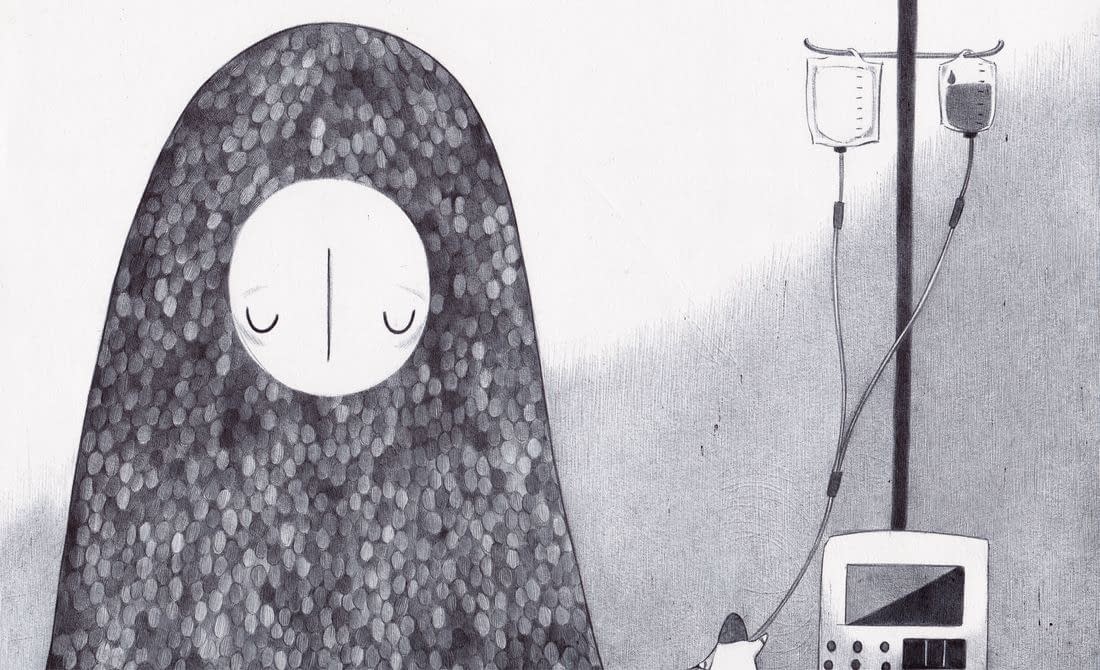
Bird: You were recently elected Youth Comics Laureate of the United Kingdom. What has that experience been like so far?
Ray: It was really exciting. I’ve been having very brilliant conversations with Comics Youth and the Lakes International Comics Art Festival, and we’re very aligned with the things we care about. I’ve got another meeting coming up about next week where I want to put all my plans on the table with what I want to do with the time. It’s really lovely to have such aligned views about what this role could be, and I’m really excited.
Bird: You’re the first one ever to do this right?
Ray: I am, yeah! I’ve got to set the precedent for what it means.
Bird: That leads to a good kind of pressure though. It’s stressful but what you do now sets the standard for what people can do with it.
Ray: I fully intend to set the bar high and make a huge positive impact with this. It’s cool to be given that responsibility to set the ball rolling on something really awesome that will hopefully keep going.
Bird: You’ve traveled all over the world in tandem with the Lakes International Comics Art Festival. Has that changed how you view the impact of comics?
Ray: Hugely. I went to Palestine this year, which is still mad to me that I had that opportunity. You can already see the impact it’s had — we created this big, beautiful bubble while we were there, family by the end of the first day, creating this safe space where all of these artists were able to be vulnerable and talk about their experiences. You could see the impact on them, and then you step outside the bubble, and the impact that the actual printed book, the Qusasat Anthology, which is here at Thought Bubble Comics Art Festival, is having. You get to see both the impact it had on the creatives who made it and also get to see just how far-reaching that is when you put it out into the world. It’s just been amazing.

Bird: You recently worked on a project with the British Library to help young people create comics. What have some of the highlights of that been?
Ray: Similarly, just creating a safe space where you watch somebody, who has a story they need to express, find confidence and the ability to express their story creatively. That confidence also helps them process their experiences, and then seeing how important and positive it is to share that with the world and how it helps other people is just wonderful. It’s beautiful to offer something so positive to someone who may only have negative associations with their experiences.
Bird: Do you have anything else upcoming for readers to look forward to?
Ray: I am producing a comic at the moment with LICAF which is telling the story of a 93-year-old Palestinian lady whose story was going to be otherwise lost. It’ll be retelling her story, which none of us want to be forgotten. She’s a survivor of Nakba, so it’s a very important story that would resonate with a lot of people. I’m also pitching another book!
